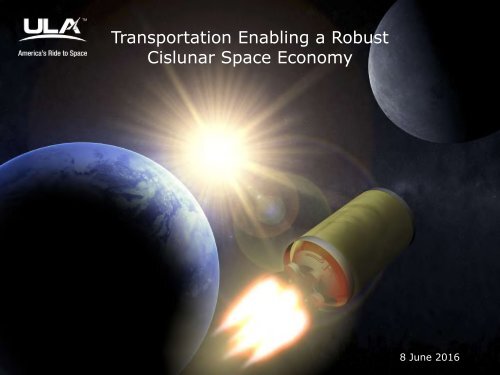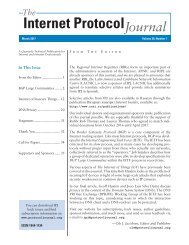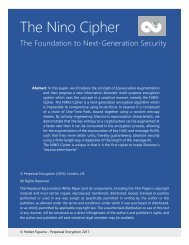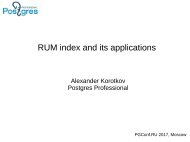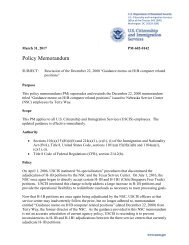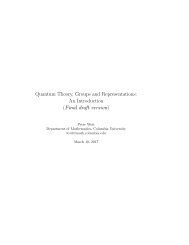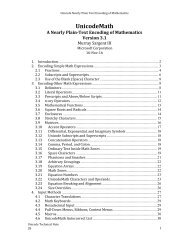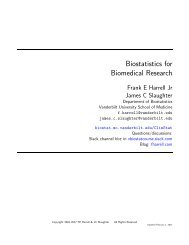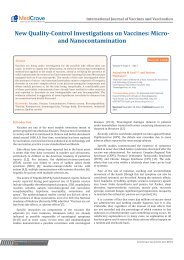Transportation Enabling a Robust Cislunar Space Economy
28M7a4S
28M7a4S
Create successful ePaper yourself
Turn your PDF publications into a flip-book with our unique Google optimized e-Paper software.
<strong>Transportation</strong> <strong>Enabling</strong> a <strong>Robust</strong><br />
<strong>Cislunar</strong> <strong>Space</strong> <strong>Economy</strong><br />
8 June 2016<br />
Copyright © 2016 United Launch Alliance, LLC.<br />
Unpublished Work. All Rights Reserved.
<strong>Space</strong> Commercialization<br />
<br />
The sustainability of the space enterprise hinges on the<br />
establishment of a robust space economy.<br />
• Otherwise, space activities are the sole purview of governments<br />
<br />
Commercialization of space harnesses the positive forces of the<br />
free market<br />
• Innovation, efficiency, competition, growth<br />
For the benefit of consumers<br />
<br />
<strong>Cislunar</strong> space is where it has to start because all consumers<br />
live on Earth<br />
The ultimate goal is not to impress others, or merely to explore our planetary<br />
system, but to use accessible space for the benefit of humankind.<br />
—John Marburger, 2006
16 June 2016 | 2<br />
<strong>Cislunar</strong> 1000 Vision
16 June 2016 | 3<br />
<strong>Cislunar</strong> 1000 Vision
GEO<br />
<strong>Cislunar</strong> Econosphere<br />
NEO<br />
∆V=3.77<br />
∆V=0.50-2.00<br />
∆V in (km/s)<br />
LEO<br />
∆V=1.40<br />
∆V=0.65<br />
∆V=2.52<br />
∆V=4.33<br />
EML1<br />
LLO<br />
∆V=1.90<br />
ETO ∆V=9.53<br />
LEO<br />
ISS<br />
Remote Sensing<br />
Commercial Station<br />
Communication<br />
<strong>Space</strong> Control<br />
Debris mitigation<br />
Science<br />
R&D<br />
Tourism<br />
Manufacturing<br />
Propellant Transfer<br />
Data 16 June Servers<br />
2016 | 4<br />
GEO<br />
Observation<br />
Communication<br />
<strong>Space</strong> Control<br />
Debris Mitigation<br />
<strong>Space</strong> Solar Power<br />
Repair Station<br />
Satellite Life extension<br />
Harvesting<br />
High Earth Orbit<br />
Science / Astronomy<br />
Communication Link<br />
Way Station<br />
Propellant Depots<br />
Repair Station<br />
Lunar Solar Power Sat<br />
Manufacturing<br />
Planetary Defense<br />
Existing market / Emerging market \ Future market<br />
Lunar Surface<br />
Science/ Astronomy<br />
•Lunar<br />
•Observatory<br />
Human Outpost<br />
Tourism<br />
Mining<br />
•Oxygen/Water<br />
•Regolith<br />
•Rare Earth Elements<br />
•HE3<br />
Manufacturing<br />
Fuel Depots<br />
Solar Power to Earth
<strong>Cislunar</strong> <strong>Transportation</strong> System<br />
ACES<br />
(Advanced Cryogenic<br />
Evolved Stage)<br />
Fueled with LO2 and LH2<br />
propellant provided from:<br />
• Earth<br />
• Moon<br />
• Asteroids<br />
XEUS<br />
Reusable <strong>Transportation</strong> Avoids Earth’s Deep Gravity Well<br />
16 June 2016 | 5
Lunar Water<br />
Water at Lunar poles<br />
–Cold Traps in Craters<br />
–~10B mT per pole<br />
Fuel, Water, Oxygen<br />
Lunar Reconnaissance Orbiter<br />
Credit:<br />
LRO Camera Team<br />
Paul Spudis<br />
16 June 2016 | 6<br />
Credit: Chris Meaney / NASA 2008
Business Model<br />
LEO GEO EML1<br />
<<br />
ACES Cargo<br />
<<br />
XEUS tanker (full)<br />
ACES tanker (full)<br />
Payload<br />
Launch to<br />
LEO<br />
16 June 2016 | 7<br />
Cargo Flow<br />
1. Launch to LEO<br />
2. Refuel Cargo ACES<br />
3. Transport to GEO<br />
4. Deploy cargo<br />
Propellant Flow<br />
1. Mined on moon<br />
2. XEUS transport to EML1<br />
3. Transfer from XEUS to ACES<br />
4. ACES transport to LEO<br />
5. Transfer to cargo ACES
Cost of Resources<br />
($/kg)<br />
Costs of Resource in <strong>Cislunar</strong> <strong>Space</strong><br />
GEO<br />
LEO<br />
EML1<br />
LLO<br />
$35k/kg<br />
$20k<br />
$15k<br />
$10k<br />
Cost From Earth<br />
$5k<br />
$0k<br />
$0.001k/kg<br />
Earth<br />
Cost From the Moon<br />
LEO GTO GSO L1 Moon<br />
$0.5k/kg
Business Case<br />
Key assumptions<br />
• If propellant can be purchased in LEO for less than the cost to ship it<br />
from Earth, then the price per kg to GEO can be reduced<br />
Price point = $3M/mT<br />
• For sizing, assume 3 ACES cargo flights per year<br />
Derived requirements:<br />
Price in LEO $3M/mT Required to close business case<br />
Prop delivered to LEO 210 mT/yr assumption<br />
Lunar propellant produced 1050 mT/yr Based on ACES/XEUS transport from moon<br />
to LEO<br />
Water mined 1575 mT/yr Based on propellant MR of 5.5<br />
Price at the moon $0.5M/mT Based on cost to transport to LEO.<br />
Aerobraking could increase affordability by<br />
2-3X<br />
16 June 2016 | 9
Lunar Mining<br />
More assumptions:<br />
• 10 year life of mining/production facility<br />
• 10% return on sales (ROS)<br />
• $50k/kg cost of equipment on Earth<br />
• $35k/kg cost to transport to lunar surface (Vulcan/XEUS)<br />
• $3k/kg-yr cost to operate plant<br />
More derived requirements:<br />
Plant mass 40.5 mT Affordability limit<br />
Plant efficiency 25.5 kg/yr /kg Annual propellant output per kg of plant<br />
HW<br />
Plant development cost $2.02B $50,000/kg<br />
Plant delivery cost $1.47B $35,000/kg<br />
Total non-recurring cost $3.49B Development + delivery<br />
16 June 2016 | 10
What next?<br />
Is a lunar mining operation feasible within the parameters given?<br />
• Likely requires full robotics, very rich ice fields, clever extraction<br />
approaches, catalytic electrolysis, etc.<br />
• Solar power is unlimited but consumes budget.<br />
Improvements can be made<br />
• Aerobraking can significantly improve the business case<br />
• Propellant at higher orbits can potentially command higher prices<br />
• Private-public partnerships<br />
However, once started, a virtuous cycle can be sparked<br />
• The second propellant plant will be much lower cost<br />
Transport cost reduced by >2X using lunar propellant<br />
HW cost for 2 nd unit should be much less<br />
16 June 2016 | 11
The Moon has unique significance for all space applications for a reason that<br />
to my amazement is hardly ever discussed in popular accounts of space<br />
policy. The Moon is the closest source of material that lies far up Earth's<br />
gravity well. Anything that can be made from Lunar material at costs<br />
comparable to Earth manufacture has an enormous overall cost advantage<br />
compared with objects lifted from Earth's surface. The greatest value of the<br />
Moon lies neither in science nor in exploration, but in its material.<br />
—John Marburger, 2006<br />
16 June 2016 | 12<br />
Credit: NASA/Zuber, M.T. et al., Nature, 2012


